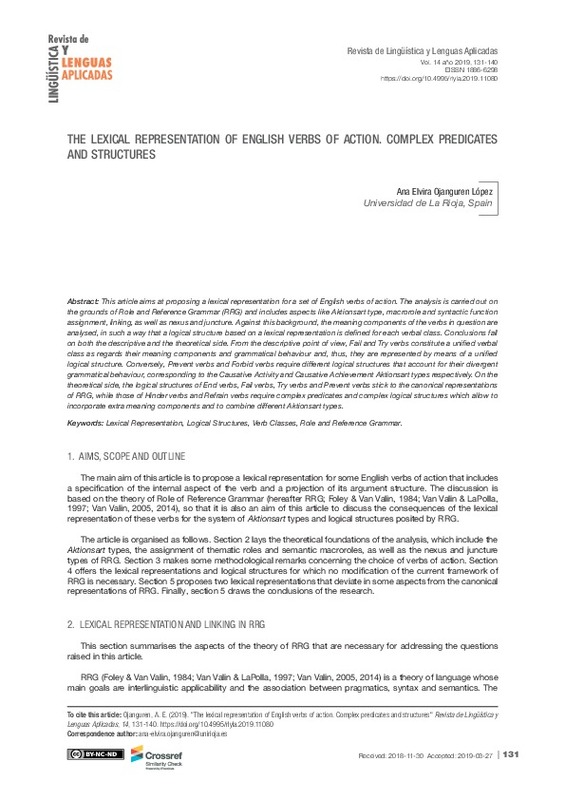JavaScript is disabled for your browser. Some features of this site may not work without it.
Buscar en RiuNet
Listar
Mi cuenta
Estadísticas
Ayuda RiuNet
Admin. UPV
The lexical representation of English verbs of action. Complex predicates and structures
Mostrar el registro sencillo del ítem
Ficheros en el ítem
| dc.contributor.author | Ojanguren López, Ana Elvira
|
es_ES |
| dc.date.accessioned | 2019-07-22T09:28:50Z | |
| dc.date.available | 2019-07-22T09:28:50Z | |
| dc.date.issued | 2019-07-19 | |
| dc.identifier.issn | 1886-2438 | |
| dc.identifier.uri | http://hdl.handle.net/10251/123902 | |
| dc.description.abstract | [EN] This article aims at proposing a lexical representation for a set of English verbs of action. The analysis is carried out on the grounds of Role and Reference Grammar (RRG) and includes aspects like Aktionsart type, macrorole and syntactic function assignment, linking, as well as nexus and juncture. Against this background, the meaning components of the verbs in question are analysed, in such a way that a logical structure based on a lexical representation is defined for each verbal class. Conclusions fall on both the descriptive and the theoretical side. From the descriptive point of view, Fail and Try verbs constitute a unified verbal class as regards their meaning components and grammatical behaviour and, thus, they are represented by means of a unified logical structure. Conversely, Prevent verbs and Forbid verbs require different logical structures that account for their divergent grammatical behaviour, corresponding to the Causative Activity and Causative Achievement Aktionsart types respectively. On the theoretical side, the logical structures of End verbs, Fail verbs, Try verbs and Prevent verbs stick to the canonical representations of RRG, while those of Hinder verbs and Refrain verbs require complex predicates and complex logical structures which allow to incorporate extra meaning components and to combine different Aktionsart types. | es_ES |
| dc.description.sponsorship | This research has been funded through the grant FFI2107-83360P, which is gratefully acknowledged. | es_ES |
| dc.language | Inglés | es_ES |
| dc.publisher | Editorial Universitat Politècnica de València | |
| dc.relation.ispartof | Revista de Lingüística y Lenguas Aplicadas | |
| dc.rights | Reconocimiento - No comercial - Sin obra derivada (by-nc-nd) | es_ES |
| dc.subject | Lexical Representation | es_ES |
| dc.subject | Logical Structures | es_ES |
| dc.subject | Verb Classes | es_ES |
| dc.subject | Role and Reference Grammar | es_ES |
| dc.title | The lexical representation of English verbs of action. Complex predicates and structures | es_ES |
| dc.type | Artículo | es_ES |
| dc.date.updated | 2019-07-22T06:59:10Z | |
| dc.identifier.doi | 10.4995/rlyla.2019.11080 | |
| dc.relation.projectID | info:eu-repo/grantAgreement/AEI/Plan Estatal de Investigación Científica y Técnica y de Innovación 2013-2016/FFI2017-83360-P/ES/CORPUS PARALELO DE PROSA DEL INGLES ANTIGUO. ETIQUETADO, ANOTACION Y ESTUDIOS LINGUISTICOS RELACIONADOS/ | es_ES |
| dc.rights.accessRights | Abierto | es_ES |
| dc.description.bibliographicCitation | Ojanguren López, AE. (2019). The lexical representation of English verbs of action. Complex predicates and structures. Revista de Lingüística y Lenguas Aplicadas. 14:131-140. https://doi.org/10.4995/rlyla.2019.11080 | es_ES |
| dc.description.accrualMethod | SWORD | es_ES |
| dc.relation.publisherversion | https://doi.org/10.4995/rlyla.2019.11080 | es_ES |
| dc.description.upvformatpinicio | 131 | es_ES |
| dc.description.upvformatpfin | 140 | es_ES |
| dc.type.version | info:eu-repo/semantics/publishedVersion | es_ES |
| dc.description.volume | 14 | |
| dc.identifier.eissn | 1886-6298 | |
| dc.contributor.funder | Agencia Estatal de Investigación | es_ES |








